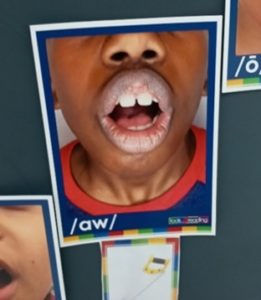“I’m going to curl my lower lip back and let my upper row of teeth come down and rest on my lip.”
“Gently blow air through a very small opening between your teeth and the lower lip.”
“Now can you make the /f/ sound on your own?”
Across the country, many educators are learning about phonetics and the science of reading. The science of reading incorporates insights and research from disciplines that include developmental psychology, educational psychology, cognitive science, and cognitive neuroscience. Tools4Reading provides materials and professional learning for educators to improve their literacy instruction grounded in the science of reading.
One product sold by Tools4Reading are their Kid Lips™ Picture Cards. These picture cards are a “helpful resource for teaching phonemic awareness: how sounds are produced, how they are perceived, and their physical aspects. Picture cards of children’s mouths are used to teach and show the correct placement of the tongue, teeth, and lips when producing the target phoneme” (Tools4Reading, 2022). Having a Master’s in Reading Education and almost 17 years as a reading specialist and elementary classroom teacher, I know the value and power in building a solid phonemic awareness foundation. I am pleased with the idea behind creating the Kid Lips™ Picture Cards; however, that is where the appeal ends for me. With the idea.
I recently had the opportunity to put my eyes on a set of Kid Lips™ Picture Cards displayed on a wall in an elementary classroom. All of the good I envisioned was destroyed when I viewed the dehumanization of yet another handsome Black body. Black bodies have been begging, imploring, and pleading to be seen as fully human in K-12 learning spaces for quite some time. Yet this was another example of how racist ideology and subconscious associations led the Tools4Reading company and hundreds (possibly thousands) of educators to deem it appropriate to display a Black boy’s lips from a disparaging point of view, as they can be viewed as dry, chapped, and not hydrated or as moisturized as the lips of his peers.



For centuries, Black people have been associated with dehumanizing stereotypes and crude depictions of animals, monsters, and creatures. Society has been conditioned by the brutalizing violence of animal comparisons and simianized representations so often that despite widespread opposition to racism, bias remains with us. The thought that subpar expectations are acceptable for Black boys and girls remains salient in our educational spaces.
The Tools4Reading website states that they “now have updated and diverse pictures!” I am intrigued by this sentence. As I think back to the Kid Lips™ Picture Cards I viewed on display, I noticed some variation in hues and skin tones, varying ages, and hair colors of the children on the cards. However, it really stood out that the only child who had aesthetically different lips was the child whose race has historically been seen as subhuman and implicitly portrayed as bestial or simian.
In 1854, scientists George Gliddon and Josiah Nott documented the racial hierarchies they observed, comparing Black people to orangutans, chimpanzees, and gorillas. Between 1979 and 1999, the Philadelphia Inquirer published hundreds of stories describing Black people and White people convicted of capital crimes. The Black people were four times more likely to be described as barbaric, beast, savage, brute, and wild. “Those who were implicitly portrayed as more apelike in these articles were more likely to be executed by the state than those who were not” (Marie, 2021). This is a battle of humanity. This is a battle of awareness. This is a battle of intentionality. This is a battle to be consciously recognized as fully human, on every wall – kids’ lips and all.
The harmful consequences are significant if educators, researchers, and curriculum developers do not stop to check for their everyday racist practices, such as marginalizing those identified as racially different from the dominant culture. Children experiencing these occurrences have higher levels of depression, impaired psychological wellbeing, decreased self-esteem, and physical ailments.
This is how YOU see me? So, what are you going to do?




